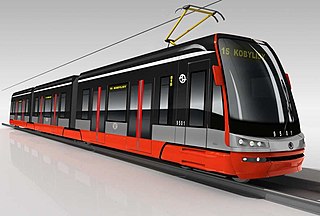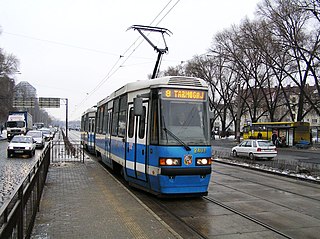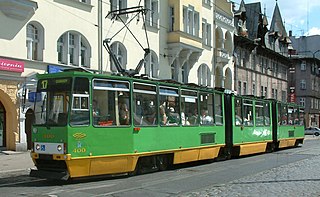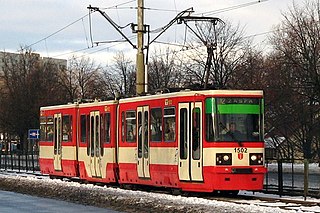
Silesian Trams is one of the largest tram systems in the world and the largest and longest tram system in Poland, located entirely within the Silesian Voivodeship. Started as a part of the German Empire in 1894, the system currently has 677 stops across 29 lines and serves the region’s population inhabited by more than two million people. Silesian Trams is at the heart of a region known for its dense historical and current industrialisation.

Konstal 105N is a family of electric trams designed by Konstal, a Polish company based in Chorzów, produced between 1973 and 1979.

Nr I is a class of articulated six-axle, chopper-driven tram operated by Helsinki City Transport on the Helsinki tram network. All trams of this type were built by the Finnish metal industry corporation Valmet between the years 1973 and 1975.

The ADtranz low floor tram was introduced in the 1990s as the world's first tram with a completely low floor design. This tram was developed by MAN for the Bremen urban transport system. The prototype, tram number 3801, was first publicly introduced on 9 February 1990. From 1991 to 1993, it was being tested in many European cities. Ten German cities have purchased this type. Adtranz took over the rail division of MAN in 1990.

The T3 is a type of Czech tramcar produced by ČKD Tatra. A late-2000s study conducted on the Prague tram system has shown 98.9% reliability, the best of the Prague tram system fleet. During its period of production between 1960 and 1999, 13,991 powered units and 122 unpowered trailers were sold worldwide.

The Tram 2000 is a type of tram vehicle that was originally designed for the Verkehrsbetriebe Zürich (VBZ), the municipal transport operator of the Swiss city of Zürich, and first introduced in 1976. Other variants of the type were subsequently built for the VBZ, for other Swiss operators, and for the Italian city of Genoa. The last vehicles to the design entered service in 1994, but the type is still in front line service with all its original users.

The Indian locomotive class WAG-5 is a class of 25 kV AC electric locomotives that was developed in 1978 by Chittaranjan Locomotive Works for Indian Railways. The model name stands for broad gauge (W), alternating current (A), goods traffic (G) engine, 5th generation (5). They entered service in 1980. A total of 1196 WAG-5 were built at CLW and BHEL between 1978 and 1998, which made them the most numerous class of mainline electric locomotive till its successor the WAG-7.

The Poznań tram system is a tramway operated by Miejskie Przedsiębiorstwo Komunikacyjne w Poznaniu Sp. z o.o.. It currently has 20 daytime lines, one night line, and one tourist line served by historical vehicles. The tram system consists of about 66 kilometres (41 mi) of route, operating on 1,435 mmstandard gauge track. With a few exceptions the tramlines operate on double tracks rail.

Škoda 15T is a 100% low-floor multiple-unit tram developed by VUKV a.s. and built by Škoda Transportation in Pilsen for the Prague tram network. It was a successor to the Škoda 14 T, featuring articulated bogies and more power to correct for problems found during the operation of the 14 T. The 15T has articulated bogies at either end of the train, and Jacobs bogies between the segments. The tram has two double-doors in each segment to allow fast boarding of passengers, and one extra side door leading to the driver's cabin.

Moderus Alfa – a one-section one-directional high-floor tram model developed by retrofitting Konstal 105N/105Na tram, manufactured by Modertrans Poznań. These trams are operated in Silesian Interurbans, Poznań and Szczecin.

The Wrocław tram system is the tram system in Wrocław, Poland.

Konstal 105NWr is a Polish tram resulting from the modernization of the tram Konstal 105Na by Protram plants.

The Kraków tram system is a tram system in Kraków, Poland. The tramway has been in operation since 1882, and is currently operated by Miejskie Przedsiębiorstwo Komunikacyjne w Krakowie. There are 22 ordinary, 2 fast, and 3 night tram lines with a total line length of 347 kilometres (216 mi). As of 2013, the total route length of the tramway was 90 kilometres (56 mi), including a 1.4-kilometre (0.87 mi) tram tunnel with two underground stops.

Tatra KT4 is the name of a four-axle type articulated tramcar developed by the Czech firm ČKD Tatra. The first pre-production vehicles entered service in Potsdam in 1975, with the first production vehicles in 1977. A total of 1,747 units were built, with initial deliveries to East Germany (DDR) and later to the USSR and SFR Yugoslavia. KT4 variants were built for both standard gauge and metre gauge tramways. Production of the KT4 tramcar was halted in 1991 due to worldwide economic and political changes at the time. Production was briefly resumed in 1997 to construct the last 20 units for Belgrade, Serbia.

Alstom Konstal is a company based in Chorzów, Poland producing rail vehicles, in particular metro cars and trams, as well as components for trains.

The Konstal 13N was an electric tram built by Konstal in Chorzów between 1959 and 1969 and used in Warsaw until 2012. The design borrowed heavily from the PCC-derived ČKD Tatra T1.

Konstal 102N was an electric tram built by Konstal in Chorzów between 1969 and 1970, replacing the Konstal 13N.

Konstal N was a tram model based on the German Kriegsstraßenbahnwagen concept, manufactured between 1948 and 1956 by the companies Konstal in Chorzów, Gdańsk Shipyard no. 3 and Sanok Railcar Factory "Sanowag". The narrow-gauge version was built from 1950 to 1956. Trailers were marked ND or 2ND. The N was the first tram manufactured in Poland after the Second World War.

HCP 115N – the first Polish prototype partially low-floor tram that was produced by H. Cegielski factory in Poznań. It was made in 1995 from two Konstal 105N cars used by MPK Poznań and in service until 2006. In 2011 the tram has been scrapped.

Konstal 114Na is an articulated low-floor tram, manufactured in 1997 by Konstal works in Chorzów, in a quantity of 2 units for the Gdańsk Municipal Transport Company. It is the second low-floor tram type produced in Poland after the 112N. A significant part of the solutions was taken from the previously produced single unit of the 112N type.
























































